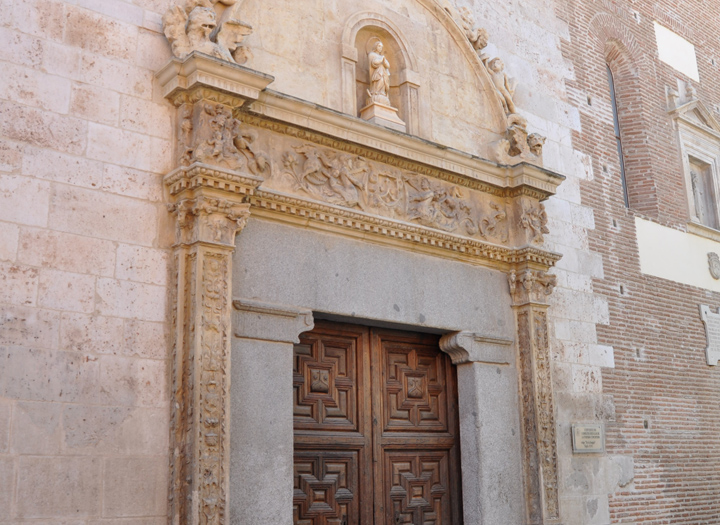On the banks of the famous Henares, to which your golden Tagus, beautiful shepherdesses, always pays fresh and pleasant tribute, I was born and raised, and with not such bad luck that I was the worst off in the village.
First Book of Galatea
Declared a World Heritage Site by UNESCO on December 2 1998, Alcalá de Henares is the birthplace of Miguel de Cervantes. His father, D. Rodrigo de Cervantes, was born there and it was also where he married doña Leonor de Cortinas in 1543. In their first years of being married five of their children were born in this same city, Miguel, who was born on September 29 1547, included.
If we go back a few centuries, Alcalá de Henares remerged as a city with the discovery of the buried remains of the Saintly Children Justo and Pastor. This event spurred the diocese to settle in the area and brought with it a gradual growth in the urban area centred around the current Magistral Cathedral. During the early Middle Ages the city was divided into three different quarters, in the same way as other Spanish cities like Toledo and Cordoba: the Christian quarter, the Moorish quarter and the Jewish quarter.
The Jewish quarter was known for its main street (the current Calle Mayor), an arcaded street that was home to a large part of Alcalá de Henares’ Jewish businesses. Years later the Cervantes family moved to this very street, to a house next to the Hospital de Antezana (founded in 1485 in the former stately home belonging to D. Luis de Antezana and doña Isabel de Guzmán). There is evidence in documentary sources of another property that was bought by Juan de Cervantes, the writer’s grandfather. That property was known as the Casa de la Calzonera and was located opposite Miguel de Cervantes’ family home, where the current Museo Casa Natal de Cervantes is situated.
The city centre, which centuries before had been the area around the Magistral Cathedral, moved to the Plaza del Mercado (known today as Plaza de Cervantes). Before Miguel de Cervantes was born, the square was located outside the city walls. During the 15th century the area was being repopulated and buildings as emblematic as the now defunct San Juan de los Caballeros Church, the Santa María la Mayor parish, with its chapels by Luis de Antezana, and the Oidor (the current Centro de Interpretación, where a copy of Miguel de Cervantes’ baptismal certificate and a reproduction of the baptismal font where he was baptised are displayed) were being constructed.
The area was chosen by Cardinal Cisneros to found his University in 1499, which was the final impetus for Alcalá de Henares. The university opened its doors in 1508, which brought years of economic and, above all, cultural strength to the city. People such as Antonio de Nebrija, Quevedo, Lope de Vega, Calderón de la Barca and Tirso de Molina among others passed through its doors.
The university was made up of several religious and secular schools. The Colegio Mayor de San Ildefonso, the headquarters of the current university, is the most well known because of its façade, designed by Rodrigo Gil de Hontañón in 1537 in the plateresque style. This building, along with the colleges, brought about an increase in the population. According to census information from Castile, the number of inhabitants in Alcalá was around 2,000 in the mid-16th century.
With the arrival of the student population new businesses began to open up: bookshops, tanneries, butcher shops, etc. One of these businesses, the publishing house belonging to Juan de Gracián, stands out due to its connection to Cervantes as it was where the bookseller from Madrid, Blas de Robles, had La Galatea printed in 1585. At number 9 of the current Calle Libreros (Bookseller Street), whose name tells us that that is where bookshops and printing houses were located, is a plaque that reminds us of its connection to our writer.
In addition to commercial business, the city opened up to new festive and cultural possibilities. As a result, in 1602 the Corral de Comedias de Alcalá (the Alcalá Courtyard Comedy Theatre) was constructed. The carpenter Francisco Sánchez was commissioned and, following the designs of the Corral Príncipe (Prícipe Courtyard Theatre) and Corral de la Cruz (Corral de la Luz Courtyard Theatre) in Madrid, he built a space in which theatre companies, such as those of Nicolás de los Ríos and Gaspar de Porres, brought to the stage several comedies that Miguel de Cervantes had written after 1585.
Another place with a Cervantes connection is the former College de la Madre de Dios de los Teólogos (the current College of Architects). At the college, situated in the Santa María alleyway, was the Fe de Erratas, which brought together all published books, with all their typographical errors already made when they went to the printing house. Thanks to the first page of Don Quixote we know that on December 1 1604 in the college of the Universidad de Alcalá de Henares the lawyer Francisco Murcia de la Llana certified with this testimony that there were no errors in the original text.
The last known connection between Alcalá de Henares and the author of Don Quixote dates from July 2 1613. Like his sisters, Andrea and Magdalena, and his wife Catalina, Miguel de Cervantes became a novice of the Venerable Third Order of Saint Francis. He undoubtedly wanted to make his vows when his sister Luisa was there.
Sister Luisa Belen, as she was known in the convent of the Discalced Carmelites, would soon be the chosen priory for the Convent de la Imagen; and what is more, she would be chosen on three separate occasions. The convent, at number 7 Calle de la Imagen, had been founded as an institution by the blessed Sister María del Jesús in 1563 with the patronage of doña Leonor de Mascarenhas.
Reproducción de la pila bautismal de Cervantes










